
Bombers vs Saints Preview
- thebombersblog

- Aug 13
- 8 min read
Ground zero?
Friday night lights at Marvel Stadium await as the countdown to the season’s end continues, a season most Essendon supporters would happily erase from memory.
Yet, in a year where the lows have outweighed the highs, there’s hopefully a silver lining: 14 players have made their debut, ten of them in their very first season on an AFL list.
Maybe, when the sting of 2025 has faded, this will be remembered not for the scoreboard but as the turning point, the year the next generation laid the groundwork for the club’s next era of success.
Last time.
How do you sum up Essendon’s last clash with St Kilda, other than to say it was, in my view, their worst showing of 2024, one that showed just how far they still were from being a fully functioning team.
While there were early concerns around contest, both at stoppages and across the ground, and decision-making with ball in hand, it wasn’t until midway through the second quarter that Essendon’s inability to defend without the football really showed.
From that point until halfway through the third, St Kilda piled on eight unanswered goals, with Essendon unable to apply any pressure ahead of the ball to slow transition, leaving the defenders overwhelmed and unable to cope.
By game’s end, the Saints had taken 133 uncontested marks, aiding their ball movement and allowing them to find 20 marks inside 50 from just 43 entries. Those entries produced 28 shots at goal at a rate of 65.1% — almost 11% above the competition’s number one side in 2024.
To respond to a close loss to Adelaide the previous week with a performance like that, with only five games remaining, from a team sitting eighth on the ladder, just one win off the top four, and facing an opponent in 15th, was deeply disappointing at such a critical point in the season.
This week.
This season, I have been tracking some key performance indicators that I believe are essential for success in the modern game. Some focus on attacking with the football, while others reveal insights on defending without it. This preview covers most of those areas, comparing Essendon and this week’s opponent St Kilda against the competition as a basis for analysis.
Stoppages.

-Essendon finished -3 in pre-clearance contested possessions against the Bulldogs and +3 against the Swans two and three weeks ago, both top-eight ranked sides in this area.
-Both Essendon and St Kilda sit mid-table for turning first possession at stoppages into a clearance, but the Bombers rank top-three in the AFL for stripping it off the opposition after they get first hands (ranked top-five most of the season).
-St Kilda’s edge in clearances is around the ground rather than at centre bounce. Both sides are below average for scores from the centre square.
-Jack Macrae ranks 3rd in the competition for winning clearances, while Sam Durham is Essendon’s highest-ranked player available for selection this week, ranked 32nd (minimum five games played)
Clearance to shot at goal rate.
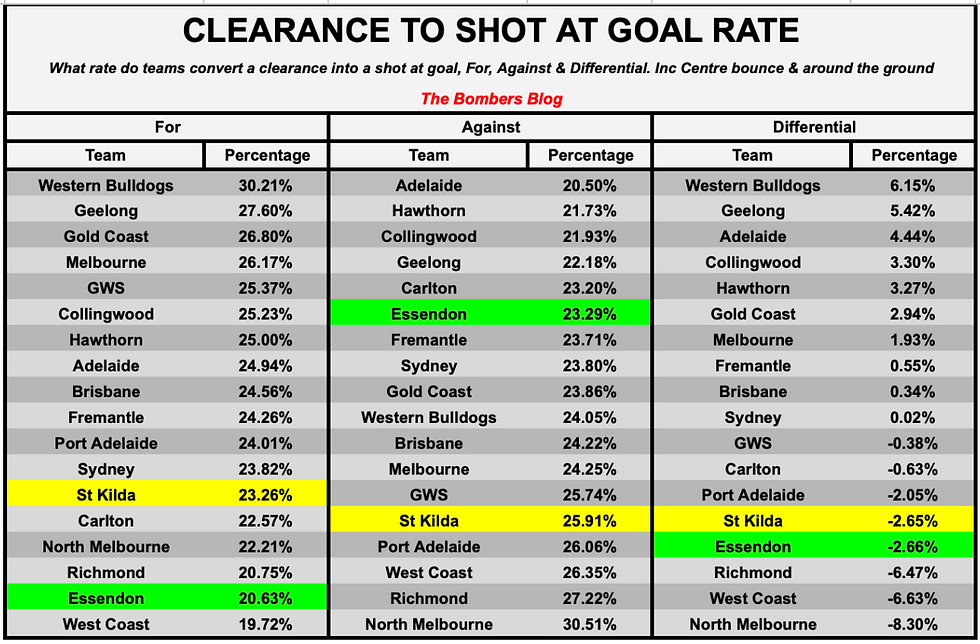
-Essendon has been poor at converting clearances into shots on goal, averaging just 6.16 shots per game from this source since the bye. St Kilda hasn’t fared much better in that stretch, averaging seven.
-Of all teams outside the top nine on the ladder, only Carlton defends better than Essendon at stopping clearance losses from turning into scoring shots. Since the Bombers’ bye, only GWS and Fremantle have had 10 or more shots from this source against Essendon. While St Kilda appears vulnerable here, it’s mostly been exploited by stronger opponents.
-Rowan Marshall ranks inside the top 10 rucks for starting scoring chains from his hitouts at clearance.
Possessions.
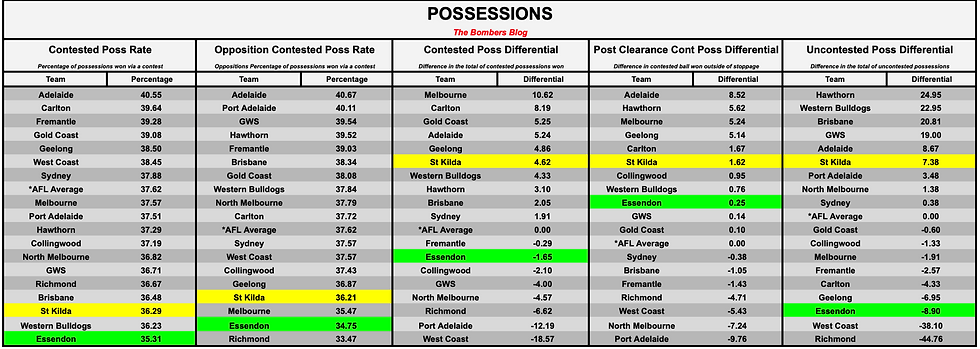
-Both teams play a very uncontested brand, both with and without the ball, allowing their opponents an unpressured game.
-There’s a huge difference between the two in uncontested possessions, and a significant turnaround from 2024. Essendon finished last year almost +23 on their opponents, second only to GWS, while St Kilda sat just above the AFL average.
-Nasiah Wanganeen-Milera averages just over 18 uncontested possessions a game, the sixth most of any player, and no one gains more territory each week with ball in hand.
-Only three players in Tom Green, Caleb Serong and Matt Rowell average more contested possessions than St Kilda’s Macrae, with 9.7 of those coming pre-clearance, both career-best numbers across his 13 seasons.
-Essendon was ranked in the top five for post-clearance possession until Dreamtime, with the defenders holding up their end, as Zach Reid was inside the top 10 players at that stage. However, this has dropped off significantly since, with the Bombers winning this battle only once (against Fremantle), when they were forced to push numbers back after losing field position from clearance.
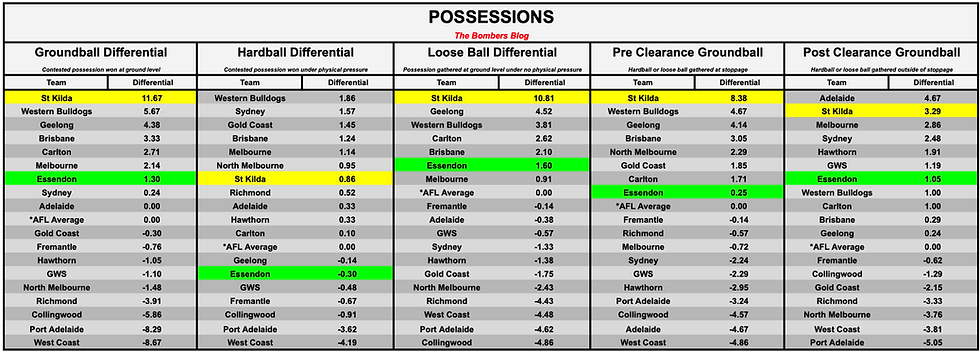
-No team is better at groundball than the Saints, and that dominance shows across almost every aspect. McCrae and Wanganeen-Millera are key here, but it’s Jack Sinclair’s possessions that generate most of their scores.
-The Bombers have held their own against top-ranked teams in loose ball: +2 against the Lions earlier this season, -1 versus the Dogs in Round 20. Unfortunately, they couldn’t match Geelong last week, losing that battle by 15.
-Andrew McGrath and Archie Roberts are Essendon’s top two players for winning post-clearance groundball, though much of McGrath’s work came earlier in the year playing as a small defender rather than a midfielder.
Forward lines.
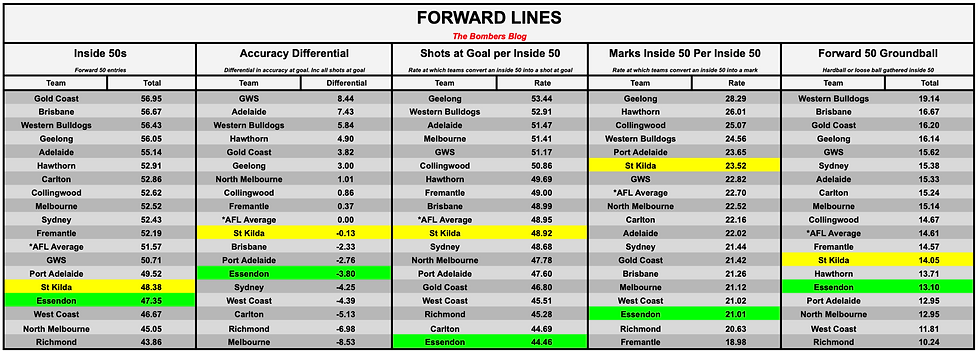
-St Kilda’s dominance at groundball continues inside 50. In Round 20 last year, they absolutely destroyed Essendon, winning 21 — the most groundballs Essendon conceded and at their worst rate per inside 50. Higgins and Cooper Sharman each won three.
-Both sides are well below average at generating inside 50 entries, with Essendon struggling particularly to find a marking option per entry. In contrast, St Kilda hits a target at a better rate than four of the top nine teams on the ladder.
-Interestingly, Essendon’s 44% shot-at-goal rate per inside 50 is still better than their 2024 figure.
-While Higgins leads the Saints in groundballs inside the forward 50, 42 of his shots at goal have come from marks or free kicks, 15 more than from general play. His average of two goals a game this season is easily a career best.
After impressing in his first two weeks against Tom Papley and Tyson Stengle, Jayden Nguyen now faces his toughest test early in his career. Unlike those two, who can work up the ground, Higgins plays much closer to goal as a pseudo full forward, presenting a distinctly different challenge for Nguyen’s defensive role.
-Peter Wright is averaging 2.3 marks inside 50 per game, ranked 16th in the competition, his most since 2022, when he kicked 53 goals at over 62% accuracy. This season, however, he’s managed just 25 goals at 49% accuracy.
Intercepting.

-Only the Western Bulldogs rank below the AFL average for opposition possessions per intercept among the top nine teams on the ladder (that alone highlights why they sit at the bottom of that group) This metric is high on my list for measuring how hard a team is to play against, and it’s an area Essendon must urgently improve in 2026.
-Losing both their first and second-choice rucks, along with key defenders, has severely hampered Essendon’s ability to intercept mark opposition kicks at a better rate than the 17th ranked team in 2025.
-Aerial contests are also a weakness for St Kilda, with only Callum Wilkie ranking in the top 50 competition-wide for intercept marks per game. Essendon will be keen to exploit this on Friday.
-On a promising note, a sizeable share of Essendon’s chains start via intercepts, although this is partly influenced by their lower clearance numbers.
-Another key metric in being hard to play against is limiting uncontested marks. Allowing 97 per game is far too high. The opposition’s rate, almost one uncontested mark per possession chain, is well off the pace compared to top-nine teams.
-In Essendon’s improved third quarter against Geelong last week, they allowed just 19 uncontested marks, compared to 26 and 35 in the first two quarters. They cannot afford to give up the 48 that Richmond allowed St Kilda in the first quarter last week.
Turnover to shot at goal rate.
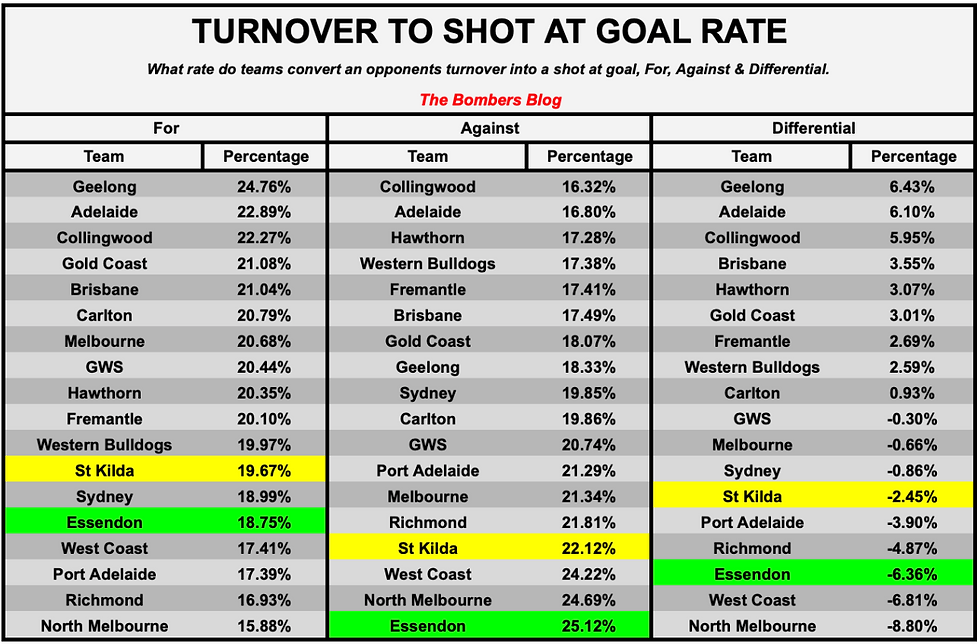
-This is the biggest indicator your system’s in order, and there’s not much more to add when one in every four turnovers ends in a score.
-The opposition’s strike rate turning Essendon turnovers into shots has steadily worsened throughout the year, but it wasn’t great earlier either.
Ball movement.

-Both teams have really struggled to move the ball from defensive 50 into forward 50 from rebounds. Essendon’s evolved through more handballs to get run going, while St Kilda rely on kick–marks, which could cause trouble if Essendon’s work rate in shutting down uncontested marks isn’t up to scratch.
-The Bombers have struggled to transition this year, and now they face the sixth hardest team to do it against. The Saints push a lot of numbers back, so blazing away by foot without building the ball up and giving teammates time to even the numbers will only make it more challenging.

-St Kilda are the highest-ranked non-finalist for points from their back half, which doesn’t line up well with the Bombers giving up over 40 points from possession chains starting in their front half.
Backline.
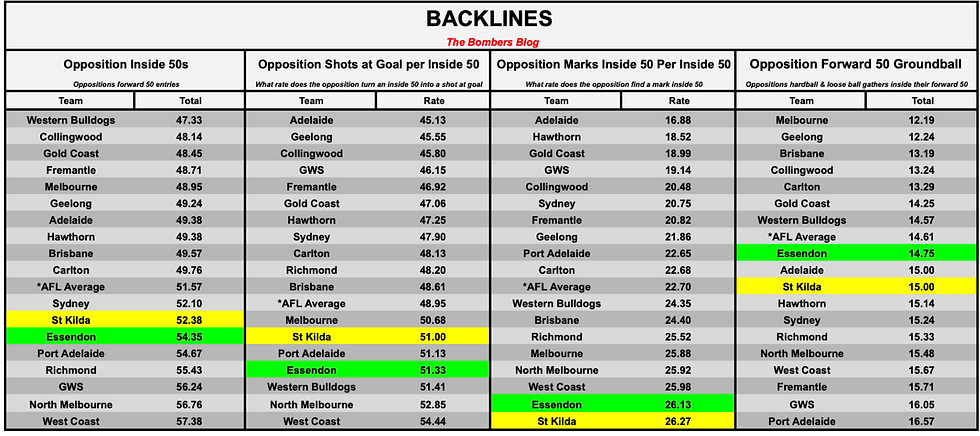
-Both teams’ defensive 50s bleed. Cannot be allowing a shot at goal over 50% of the time (Western Bulldogs in this category also) and better than one in every four entries is a set shot from a mark, the two worst teams this year.
-Anthony Caminiti is the weakness down back, as he loses over one in every three one-on-one contests in the defensive half. Is he the likely match-up for Wright? If so, with Nate Caddy and Archer May not available due to injury, it could be beneficial if Wright spent a larger portion forward.
-Only an absolute minuscule improvement from last year for Essendon in defending groundball so close to goal. If there’s one thing they can hang their hat on, it’s that they’re not allowing so much of that groundball to come from defensive-50 stoppages compared to 2024.
-Isaac Kako is the Bombers’ number one groundball winner inside 50, but to be allowed to expose the Saints in their back third, someone would need to be taking his midfield time that he was a part of last week, as well as the captain’s and Dylan Shiel’s.
Score source.
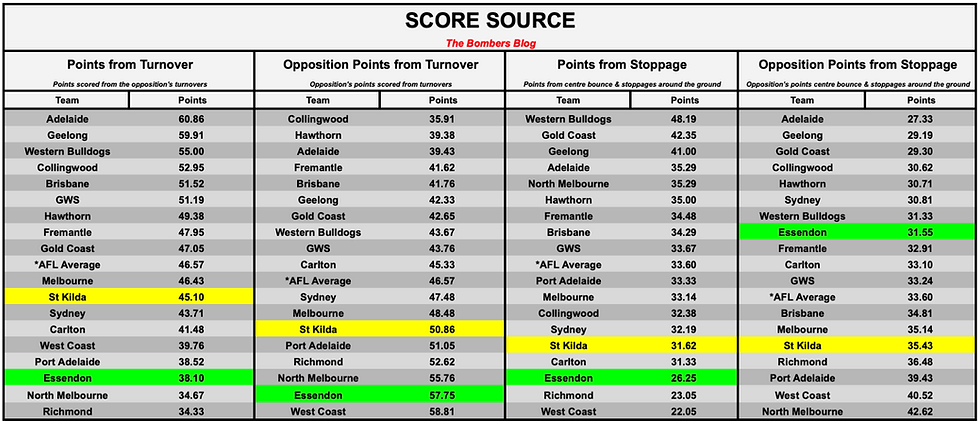
-Eighteen of the last 19 premiers have ranked in the top three for turnover differential — currently that’s Adelaide, Geelong and Collingwood, with the Western Bulldogs and Hawthorn next in line. Adelaide sat fourth in this metric in 2023 despite missing finals (we all understand the incorrect goal umpire’s decision was the reason), and after last year’s drop-off, it’s no surprise to see them rise again. Until Essendon starts trending in the right direction here, will we know if what’s being practised is genuinely sustainable in the long term.
-While some of the “damage” capabilities missing from the line-up have affected Essendon as the season has gone on, after the first 10 games this year they only averaged 42.5 points from opposition turnovers, which would push their ranking up to 13th right now.
-Only the Swans prevent fewer points from stoppages a game than the Bombers among teams out of finals contention. With the Saints averaging almost the exact same from this score source as what the Bombers concede, any difference here will have a big impact on the scoreboard.
Conclusion.
As shown, there’s little separating the two teams across most categories, with clear reasons on paper for where they currently sit in the competition.
Both sides are at different stages compared to the league’s best in terms of list development, experience, and capabilities, and for Essendon, durability to consistently field their best 23.
This gives a clear guide to what the Bombers need to focus on to bridge the gap and compete week-in, week-out with the best.
Go Bombers!






Comments